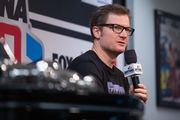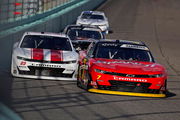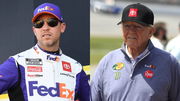
via Getty
CHARLOTTE, NC – MAY 28: Denny Hamlin (#11 Joe Gibbs Racing FedEx Ground Toyota) looks on during practice for the running of the NASCAR Cup Series Coca-Cola 600 on May 28, 2022, at Charlotte Motor Speedway in Concord, NC.(Photo by Jeffrey Vest/Icon Sportswire via Getty Images)

via Getty
CHARLOTTE, NC – MAY 28: Denny Hamlin (#11 Joe Gibbs Racing FedEx Ground Toyota) looks on during practice for the running of the NASCAR Cup Series Coca-Cola 600 on May 28, 2022, at Charlotte Motor Speedway in Concord, NC.(Photo by Jeffrey Vest/Icon Sportswire via Getty Images)
Many talk about it, but rarely has anyone come up with a solution – NASCAR’s intricate dance with fuel mileage racing. It is hardly a new concept, as saving fuel is one of the most important skills to know as a racing driver. That was evident with the NextGen car’s debut at the Brickyard 400’s glorious return.
More recently, this ‘half-throttle’ brand of racing has received a lot of flak for slowing down races and stretching out finishes. The 2024 Brickyard 400 on IMS 2.5-mile oval layout was no different. On a racetrack that big, it is only eventual for teams to come face-to-face with their respective gas mileage demons. And from Stage 2 victor Bubba Wallace to the Brickyard’s almost-champion, Brad Keselowski, seemingly nobody was safe on Sunday. But although Hendrick driver, Kyle Larson finally prevailed, his Joe Gibbs rival Denny Hamlin voiced against NASCAR’s inherent fuel efficiency on the latest episode of his podcast, Actions Detrimental.
ADVERTISEMENT
Article continues below this ad
Denny Hamlin details fuel economy conundrum days after Indy DNF
There are several ways to save fuel during a NASCAR race. You could lift in the turns to conserve a precious few quarts, or maintain a draft on tracks 2.5 miles and above in length under lower RPM. Maybe turn off the engines under caution laps like Joey Logano likely did to win that perfect display of fuel strategy a few weeks ago at Nashville; the possibilities are endless. But more than preparation, fuel mileage often turns out to be a simple game of luck and nothing more.
For example, Brad Keselowski couldn’t possibly predict the second overtime attempt at the Brickyard 400’s finish this Sunday, courtesy of the race’s 9th caution. Hence, it is quite understandable that Keselowski had to controversially give up his front-running spot to Kyle Larson after running out of his predicted fuel window set to dry up after the originally pre-determined 160 laps. He wasn’t the only one to face these consequences. Ryan Preece ran out of fuel and was spun to bring out the race’s final caution a few seconds after the white dropped for the chequered on Lap 167.
Denny Hamlin talked about Brickyard’s overtime fuel debacle on his podcast, and said, “You’re one caution away from this thing going just as planned, and then we got one caution. But then the second one was like, now that puts us in a weird fuel window where we’re short. So we’re going to have to save.”

USA Today via Reuters
Feb 16, 2024; Daytona Beach, Florida, USA; NASCAR Cup Series driver Denny Hamlin (11) during practice for the Daytona 500 at Daytona International Speedway. Mandatory Credit: John David Mercer-USA TODAY Sports
However, he brought up what some would call an unfair advantage. “But others that were in the back of the pack like the #5 because he had his issue with 90 to go or something like that. He had fuel. So he then just kind of topped off and then it just, it f***** everything up. It really did. And so we spent the whole last run having to save. And so it’s frustrating because it was very similar to like the superspeedway races that we have had all year.” Denny protested. He emphasized his own inability to go full-throttle before his P32 DNF and likened it to others who had to adjust their driving styles saying, “If the race is 160 laps… I think I ran hard 25 of those laps. So it’s just I’m so tired of running fuel mileage races where we’re all running half-throttle.”
“I wish we could do something about it,” lamented Denny. “But it’s like, I don’t know it it helps you sometimes, it hurts you sometimes. But I just think for the racing’s sake man, do we really want NBC to have to sit here and explain all these different things and fuel and all? It’s like don’t you just want to see us out there racing…? Well, he’s doing a great job explaining what’s happening, but can we stop that from happening somehow where it’s like fuel mileage races?” Indeed, it does get pretty overstimulating for many fans to actively process so much real-time digital information in the background of a holistic NASCAR race.
ADVERTISEMENT
Article continues below this ad
What’s your perspective on:
Is NASCAR's officiating ruining the sport for drivers like Denny Hamlin? What's your take?
Have an interesting take?
But the real question arises: does the sensory overload take away from the actual thrill of the race for reasons bigger than just the NextGen car’s fuel inefficiency? It would appear not, because Denny Hamlin shed light on another glowering issue that has been bothering the state of modern-day NASCAR racing for quite some time now.
Trending
The sensory overload of modern NASCAR
In a post-race conversation after his Lap 159 DNF at Indy, Hamlin pointed out the Gen 7 car’s inability to pass or perform at full potential on superspeedways and generally larger tracks. “You couldn’t pass. You’re all just running in a line there saving fuel, like a speedway race. We were just doing everything to get to the finish and didn’t make it,” he said. These words hold, especially considering Talladega and Daytona ended as fuel-mileage races with minimal lead changes causing a barrage of fan outrage. Moreover, the irony in Denny’s statement lies in the fact that Kyle Busch lost crucial track position after his #8 RCR Chevy made contact with the JGR #11 Toyota, trying to pass it for a top-5 spot. This incident sent the race into overtime in the first place.
ADVERTISEMENT
Article continues below this ad
On the other hand, race-winner Kyle Larson was languishing outside the top 20 with just 30 laps to go. Yet, with careful strategy and just a little bit of luck, he passed around 17 cars to reach Keselowski’s bumper before that scrutinized final restart. So what causes this disparity? Only three years into the NextGen experiment, some say the inception of stage racing has been detrimental to the quality of NASCAR’s weekly product. Others suggest NASCAR’s lack of permanent pit windows could act as a shot in the arm to improve the current state of the world’s premier form of stock car racing. But the true source can barely be deemed that simple.
Regardless, with the outcry growing over these constant debates, the governing body must look for permanent changes to win back certain fans who must feel even more disdain for the controversy following the return of the Brickyard 400. What do you think NASCAR must do to kick-start these changes? Let us know in the comments below.
Have something to say?
Let the world know your perspective.
ADVERTISEMENT
ADVERTISEMENT
ADVERTISEMENT
ADVERTISEMENT






Is NASCAR's officiating ruining the sport for drivers like Denny Hamlin? What's your take?